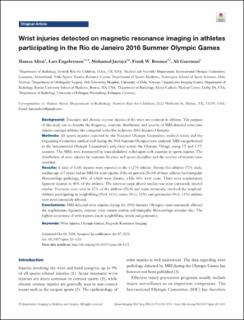| dc.contributor.author | Alizai, Hamza | |
| dc.contributor.author | Engebretsen, Lars | |
| dc.contributor.author | Jarraya, Mohamed | |
| dc.contributor.author | Roemer, Frank W. | |
| dc.contributor.author | Guermazi, Ali | |
| dc.date.accessioned | 2022-03-22T01:13:17Z | |
| dc.date.available | 2022-03-22T01:13:17Z | |
| dc.date.created | 2021-09-27T16:47:08Z | |
| dc.date.issued | 2021 | |
| dc.identifier.citation | Quantitative Imaging in Medicine and Surgery. 2021, 11(7), Side 3244-3251. | en_US |
| dc.identifier.issn | 2223-4292 | |
| dc.identifier.uri | https://hdl.handle.net/11250/2986664 | |
| dc.description | This is an Open Access article distributed in accordance with the Creative Commons Attribution-NonCommercial-NoDerivs 4.0 International License (CC BY-NC-ND 4.0), which permits the non-commercial replication and distribution of the article with the strict proviso that no changes or edits are made and the original work is properly cited (including links to both the formal publication through the relevant DOI and the license). | en_US |
| dc.description.abstract | Background: Traumatic and chronic overuse injuries of the wrist are common in athletes. The purpose of this study was to describe the frequency, anatomic distribution, and severity of MRI-detected wrist joint injuries amongst athletes who competed in the Rio de Janeiro 2016 Summer Olympics.
Methods: All sports injuries reported by the National Olympic Committee medical teams and the Organizing Committee medical staff during the 2016 Summer Olympics were analyzed. MRI was performed at the International Olympic Committee’s polyclinic within the Olympic Village, using 3T and 1.5T scanners. The MRIs were interpreted by musculoskeletal radiologists with expertise in sports injuries. The distribution of wrist injuries by anatomic location and sports discipline and the severity of injuries were recorded.
Results: A total of 1,101 injuries were reported in the 11,274 athletes. Twenty-five athletes (72% male, median-age =27 years) had an MRI for wrist injuries. Fifty-six percent (N=14) of these athletes had triangular fibrocartilage pathology, 64% of which were chronic, while 36% were acute. There were scapholunate ligament injuries in 40% of the athletes. The extensor carpi ulnaris tendon was most commonly injured tendon. Fractures were seen in 32% of the athletes (N=8) and most commonly involved the scaphoid. Athletes participating in weightlifting (N=4, 16%), tennis (N=3, 12%) and gymnastics (N=3, 12%) athletes were most commonly affected.
Conclusions: MRI-detected wrist injuries during the 2016 Summer Olympics most commonly affected the scapholunate ligament, extensor carpi ulnaris tendon and triangular fibrocartilage articular disc. The highest occurrence of wrist injuries was in weightlifting, tennis and gymnastics | en_US |
| dc.language.iso | eng | en_US |
| dc.subject | magnetic resonance imaging | en_US |
| dc.subject | Olympic Games | en_US |
| dc.subject | wrist injuries | en_US |
| dc.title | Wrist injuries detected on magnetic resonance imaging in athletes participating in the Rio de Janeiro 2016 Summer Olympic Games | en_US |
| dc.type | Peer reviewed | en_US |
| dc.type | Journal article | en_US |
| dc.description.version | publishedVersion | en_US |
| dc.rights.holder | © Quantitative Imaging in Medicine and Surgery | en_US |
| dc.source.pagenumber | 3244-3251 | en_US |
| dc.source.volume | 11 | en_US |
| dc.source.journal | Quantitative Imaging in Medicine and Surgery | en_US |
| dc.source.issue | 7 | en_US |
| dc.identifier.doi | 10.21037/qims-20-1121 | |
| dc.identifier.cristin | 1939247 | |
| dc.description.localcode | Institutt for idrettsmedisinske fag / Department of Sports Medicine | en_US |
| cristin.ispublished | true | |
| cristin.fulltext | original | |
| cristin.qualitycode | 1 | |
